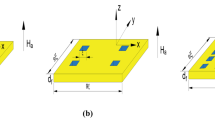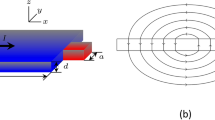Abstract
Time-dependent Ginzburg-Landau equations were solved by finite element method in two-dimensional space for order parameter and energy components of the annular superconducting sample in steady magnetic fields. Vortices preferred to penetrate from the inner surface of the annulus due to lesser energy required at the concave surface. A transition magnetic field strength was observed in spatial averages of carrier concentration and energy components, showing small bumps and abrupt variations, indicating phase transition from a non-vortex to vortex state. These effects were observed to repeat with every subsequent entry of a set of vortices into the sample; transition magnetic field strength was found to depend inversely on the annular width of the sample. The present work gives a better understanding of energy variations during phase transition from non-vortex to vortex state and predicts that vortex state can be avoided by tuning the wire thickness in practical applications, e.g., superconducting electromagnets.




Similar content being viewed by others
References
Zha, G.-Q., et al.: Superconducting phase transitions in thin mesoscopic rings with enhanced surface superconductivity. Phys. Rev. B 74(2), 024527 (2006)
Zhao, H.-W., et al.: Long-range Coulomb repulsion effect on a charged vortex in high-temperature superconductors with competing d-wave and antiferromagnetic orders. Phys. Rev. B 78(5), 064505 (2008)
Du, Q., Gunzburger, M.D., Peterson, J.S.: Solving the Ginzburg-Landau equations by finite-element methods. Phys. Rev. B 46(14), 9027 (1992)
Baelus, B., Peeters, F.: Dependence of the vortex configuration on the geometry of mesoscopic flat samples. Phys. Rev. B 65(9), 104515 (2002)
Peng, L., et al.: Variation of vortex charges in hole over-doped high-temperature superconductors with competing anti-ferromagnetic and d-wave superconducting order. J. Low Temp. Phys. 170(1-2), 91–98 (2013)
Abrikosov, A.A. Magnetic properties of superconductors of the second group. Sov. Phys.-JETP (Engl. Transl.);(United States), 1957. 5(5)
Baelus, B.J., Cabral, L.R.E., Peeters, F.M.: Vortex shells in mesoscopic superconducting disks. Phys. Rev. B 69(5), 064506 (2004)
Geurts, R., et al.: Enhanced stability of vortex-antivortex states in two-component mesoscopic superconductors. Phys. Rev. B 87(2), 024501 (2013)
Moshchalkov, V., Qiu, X., Bruyndoncx, V.: Paramagnetic Meissner effect from the self-consistent solution of the Ginzburg-Landau equations. Phys. Rev. B 55(17), 11793 (1997)
Geurts, R., Milošević, M., Peeters, F.: Symmetric and asymmetric vortex-antivortex molecules in a fourfold superconducting geometry. Phys. Rev. Lett. 97(13), 137002 (2006)
Kanda, A., et al.: Experimental evidence for giant vortex states in a mesoscopic superconducting disk. Phys. Rev. Lett. 93(25), 257002 (2004)
Geim, A.K., et al.: Paramagnetic Meissner effect in small superconductors. Nature 396(6707), 144–146 (1998)
Chibotaru, L.F., et al.: Symmetry-induced formation of antivortices in mesoscopic superconductors. Nature 408(6814), 833 (2000)
Geim, A., et al.: Non-quantized penetration of magnetic field in the vortex state of superconductors. arXiv:cond-mat/0009126 (2000)
Bezryadin, A., Ovchinnikov, Y.N., Pannetier, B.: Nucleation of vortices inside open and blind microholes. Phys. Rev. B 53(13), 8553 (1996)
Bardeen, J., Cooper, L.N., Schrieffer, J.R.: Microscopic theory of superconductivity. Phys. Rev. 106(1), 162 (1957)
Ginzburg, V.: On the theory of superconductivity. Zh. Eksper. Teor. Fiz. 20, 1064–1082 (1950)
Anderson, P.W.: Plasmons, gauge invariance, and mass. Phys. Rev. 130(1), 439 (1963)
Englert, F., Brout, R.: Nobel prize in physics: discovery of the Higgs boson and the symmetry breaking theory that predicted it. Phys. Rev. Lett 1964(13), 321 (2013)
Guralnik, G.S., Hagen, C.R., Kibble, T.W.B.: Global conservation laws and massless particles. Phys. Rev. Lett. 13(20), 585 (1964)
Higgs, P.W.: Broken symmetries and the masses of gauge bosons. Phys. Rev. Lett. 13(16), 508 (1964)
Meissner, W., Ochsenfeld, R.: Ein neuer effekt bei eintritt der supraleitfähigkeit. Naturwissenschaften 21 (44), 787–788 (1933)
Fiolhais, M.C.N., et al.: Magnetic field and current are zero inside ideal conductors. Progress In Electromagn. Res. B 27, 187–212 (2011)
Hanno, N.E., Fiolhais, M.C.N.: Meissner effect, diamagnetism, and classical physics—a review. Am. J. Phys. 80(2), 164–169 (2012)
Fiolhais, M.C.N., Hanno, N.E.: Electrodynamics of perfect conductors. Int. J. Theor. Phys. 52(4), 1701–1705 (2013)
Halperin, B.I., Lubensky, T.C., Ma, S.-k.: First-order phase transitions in superconductors and smectic-A liquid crystals. Phys. Rev. Lett. 32(5), 292 (1974)
Kleinert, H.: Disorder version of the Abelian Higgs model and the order of the superconductive phase transition. Lettere al Nuovo Cimento (1971-1985) 35(13), 405–412 (1982)
Kleinert, H.: Vortex origin of tricritical point in Ginzburg-Landau theory. EPL (Europhysics Letters) 74(4), 889 (2006)
Gammel, P., et al.: Observation of hexagonally correlated flux quanta in YBa2cu3o7. Phys. Rev. Lett. 59 (22), 2592 (1987)
Hess, H., et al.: Scanning-tunneling-microscope observation of the Abrikosov flux lattice and the density of states near and inside a fluxoid. Phys. Rev. Lett. 62(2), 214 (1989)
Essmann, U., Träuble, H.: The direct observation of individual flux lines in type II superconductors. Phys. Lett. A 24(9), 526–527 (1967)
Barba-Ortega, J., Joya, M.R., Aguiar, J.A.: Ginzburg-landau simulation of superconducting matter in a semicircular film. J. Supercond. Nov. Magn. 26(5), 2253–2255 (2013)
Peng, L., et al.: Vortex configurations in a mesoscopic superconducting ring structure: a finite-element analysis. J. Supercond. Nov. Magn. 27(4), 1217–1220 (2014)
Peng, L., Wei, Z., Xu, D.: Vortex states and magnetization properties in mesoscopic superconducting ring structures: a finite-element analysis. J. Supercond. Nov. Magn. 27(8), 1991–1995 (2014)
Cao, R., et al.: Ginzburg—landau study of superconductor with regular pinning array. J. Supercond. Nov. Magn. 26(4), 2027–2031 (2013)
Jafri, H.M., et al.: Numerical simulation of vortex dynamics in type-II superconductors in oscillating magnetic field using time-dependent Ginzburg–Landau equations. J Phys.: Condensed Matter 29(50), 505701 (2017)
Winiecki, T., Adams, C.S.: A fast semi-implicit finite-difference method for the TDGL equations. J. Comput. Phys. 179(1), 127–139 (2002)
Gropp, W.D., et al.: Numerical simulation of vortex dynamics in type-II superconductors. J. Comput. Phys. 123(2), 254–266 (1996)
Yan, Y., Moxley, F.I., Dai, W.: A new compact finite difference scheme for solving the complex Ginzburg–Landau equation. Appl. Math. Comput. 260, 269–287 (2015)
Li, B., Zhang, Z.: A new approach for numerical simulation of the time-dependent Ginzburg–Landau equations. J. Comput. Phys. 303, 238–250 (2015)
Gao, H.: Efficient numerical solution of dynamical Ginzburg-Landau equations under the Lorentz gauge. Commun. Comput. Phys. 22(1), 182–201 (2017)
Chen, L.Q., Shen, J.: Applications of semi-implicit Fourier-spectral method to phase field equations. Comput. Phys. Commun. 108(2), 147–158 (1998)
GoR’Kov, L.P., Eliashberg, G.M.: Generalization of the Ginzburg-Landau equations for non-stationary problems in the case of alloys with paramagnetic impurities. Soviet J Exp. Theor. Phys. 27, 328 (1968)
Du, Q., Gunzburger, M.D., Peterson, J.S.: Computational simulation of type-II superconductivity including pinning phenomena. Phys. Rev. B 51(22), 16194 (1995)
Acknowledgments
This work was supported by National Science Foundation of China grant numbers 11174030 and 11504020. Author HMJ acknowledge Higher Education Commission of Pakistan for PhD scholarship.
Author information
Authors and Affiliations
Corresponding author
Additional information
Supplementary Information
Supplementary Video S1 showing entrance of vortices into the annular sample is available as supplementary information, can be found at https://youtu.be/Z1mEor3TWi0.
Rights and permissions
About this article
Cite this article
Jafri, H.M., Ma, X., Zhao, C. et al. Numerical Simulation of Phase Transitions in Type-II Annular Superconductor Using Time-dependent Ginzburg-Landau Equations. J Supercond Nov Magn 31, 3445–3451 (2018). https://doi.org/10.1007/s10948-018-4586-y
Received:
Accepted:
Published:
Issue Date:
DOI: https://doi.org/10.1007/s10948-018-4586-y




